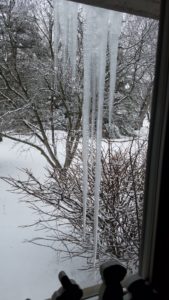Icicles typically form on days when the outdoor air temperature is below freezing but sunshine warms and melts snow or ice.
Thus, you may notice that more icicles form on the sunny south-facing side of your home than on the shaded north side.
When the sun melts snow or ice on your roof, the water flows downward and begins to drip off the roof. As the water first trickles over the edge, it forms a pendent drop suspended in the cold air. The air is below freezing, so the suspended drip starts to freeze. A thin outer-shell of ice forms on the drop. The icicle begins to form from this pendent drop.
For an icicle to grow, there must be a constant layer of water flowing over it, forming a thin fluid layer of water around the icicle. This is why icicles can feel very slippery.
The water runs down the sides in a thin film and freezes on the way down. When liquid water freezes, it releases heat. As the water along the sides of the icicle begins to freeze, the heat released by the freezing is transferred to the colder air in contact with the icicle. This small amount of heat makes a warmer layer of air that rises alongside the icicle, as it is warmer than the surrounding environment.
As this air flows upward along the icicle, it removes heat from the outer liquid layer, some of the water freezes, and the icicle grows thicker as it elongates. An icicle grows downward with an ever-progressing tip.
An icicle stops growing if water flow decreases or stops entirely. Icicles seen on a very cold day may be completely frozen, relics from a period when conditions were favorable for icicle formation. Actively growing icicles have liquid drops at the tip, and a narrow, liquid-filled tube extending upward from the tip.


